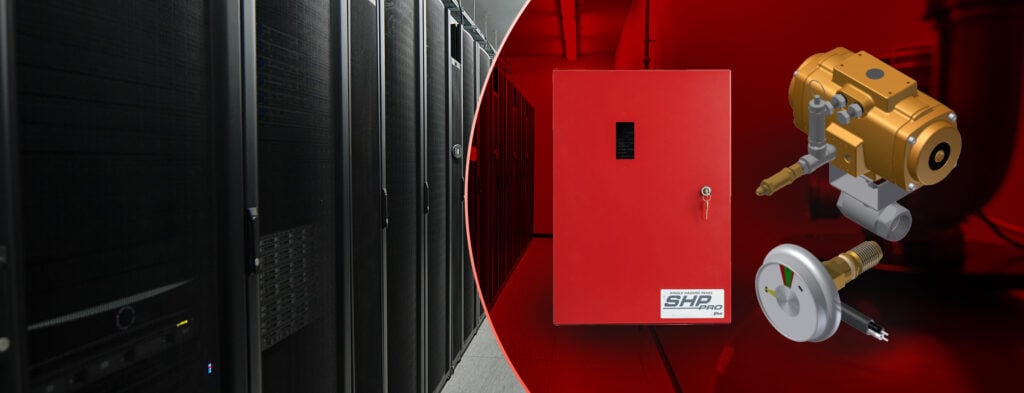
Inert gases are colorless, odorless, non-toxic, non-conductive, and chemically stable gases that do not easily undergo chemical reactions. In fire suppression systems, they are used to displace oxygen and extinguish fires without causing damage to sensitive equipment or assets. Their non-toxic nature makes them generally safer than carbon dioxide (CO₂) systems, especially in areas that may be occupied by people. The use of inert gases in clean agent fire suppression systems is governed by NFPA 2001, Standard on Clean Agent Fire Extinguishing Systems. Because inert gases are naturally odorless, these systems may incorporate an odorizer, a compound added in small amounts to provide a detectable smell, particularly in areas where human presence is expected. Odorizers enhance safety by alerting occupants to a gas discharge or leak.
A fire is started when the three conditions of the fire triangle have been met. These conditions include a fuel source, an ignition source, and an oxidizing agent. Underlying these is a chemical reaction that allows the fire to continue burning. Consequently, a continuous chemical chain reaction occurs, which involves the oxidation of the fuel source that sustains the fire. For this reason, the fire triangle is more accurately portrayed as a fire tetrahedron, where there is fuel, heat, oxygen, and an ongoing chemical reaction.
Inert gases suppress fire by disrupting the ongoing chemical reaction that sustains the fire and by displacing oxygen from the fuel source. This has several important implications when it comes to fire safety. Firstly, it means that inert gases provide an extremely effective way of suppressing fire, as the chemical reaction can no longer take place in the presence of enough inert gas. Second, the gas leaves no damage to electronics or equipment, unlike typical sprinkler suppression systems. These properties make inert gas an effective way to completely suppress fires for critical and high-risk operations.
For inert gas systems, redundant cylinder banks are a common practice for all spaces that require 24/7 protection. To fit this requirement, cylinder banks are arranged in a twin system configuration. Furthermore, actuator and signaling device wiring for both systems routes to one or two junction boxes on a common manifold. A main switch then enables selection of either the primary or secondary bank. Redundant protection can be vital to ensure your expensive equipment is protected during a disaster.
Fire Tetrahedron
The great part about inert gas suppression is that the agent is comprised of naturally occurring substances found in the atmosphere. Examples of these are nitrogen and argon, which are both naturally found in Earth’s atmosphere. As such, inert gases do not damage the ozone layer or contribute to global warming. To be precise, they have zero ozone depletion potential, zero global warming potential, and zero years of atmospheric lifetime. Due to the safe nature of these gases, they will likely not be subject to future government bans or regulations, like FM-200 and similar clean agents.
In contrast, FM-200 and similar halocarbon agents like Novec 1230 and FK-5-1-12 are active gases that chemically fight the fire as well as smothering it. While they are used for similar applications and also leave no residue on sensitive equipment, active agents also cool the fire with a chemical reaction. Consequently, a lesser concentration of gas is often required to extinguish the fire when using active clean agents. However, this does also mean that they have more environmental impact, are more costly to recharge, and different safety requirements than inert gases.
Keep Reading: 3M™ Novec™ 1230 Phase Out: Fire Suppression Alternatives >>
Gas blends are used where clean agent fire suppression is needed and the protection of people and assets is a priority. For instance, it is typically deployed in data centers, telecommunications facilities, archives, control rooms, and military installations. Even more, inert gas blends can offer additional flexibility when balancing firefighting efficiency, safety for occupants, cost, and storage space. Fike’s Proinert series comes in four different gas blends, IG-55 (50% Nitrogen, 50% Argon), IG-541 (52% Nitrogen, 40% Argon, 8% Carbon Dioxide), IG-100 (100% Nitrogen), and IG-01 (100% Argon). The ideal oxygen level for fire suppression is below 15%, but maintaining enough oxygen for human respiration is critical. Having different blends gives you the flexibility to achieve this balance in slightly different ways, either allowing more time during the egress phase, or more fire suppression capabilities. Moreover, different blends and their storage pressures can influence the size and number of cylinders required.
Fike’s Proinert is a UL and FM approved solution for inert gas fire suppression in protected spaces. Their systems allow for ease of use, with hoses from each cylinder now being routed together and no longer having to be manually attached to a manifold. Additionally, pressure gauges are pre-installed, and are not required to be removed for yearly service. Furthermore, pipe coupling pressure support is often rated to 750 psi, ensuring your configuration can support any modern inert gas system. Ultimately, Fike’s Proinert series provides a versatile, approved and user-friendly inert gas fire suppression solution, allowing both effective fire suppression and the safety of your most critical assets and personnel.
Inert gas systems interrupt the chemical reactions underlying the fire, and displaces oxygen, a critical pillar of the fire triangle. These systems extinguish fires without causing damage, allowing your business operations to resume quickly after a fire event. Even more, inert gas systems are safe for the environment, while still providing similar results to active clean agents. With options like Fike’s Proinert series, you gain the flexibility of various blends, user-friendly designs, and robust configurations, making inert gas a premier choice for safeguarding important operations. At FireAlarm.com we offer suppression system design and installations for commercial facilities and critical operations. Contact us today to discuss how we can protect your assets.
$5,051.00
$398.99
$382.99
$802.00
$704.00
$1,703.00
$736.00
$1,142.00